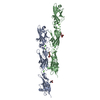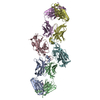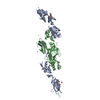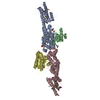[English] 日本語
 Yorodumi
Yorodumi- SASDBH3: Leucine-rich repeat transmembrane neuronal protein 2, LRRTM2 (fra... -
+ Open data
Open data
- Basic information
Basic information
| Entry | Database: SASBDB / ID: SASDBH3 |
|---|---|
 Sample Sample | Leucine-rich repeat transmembrane neuronal protein 2, LRRTM2 (fragment 30-380)
|
| Function / homology |  Function and homology information Function and homology informationNeurexins and neuroligins / neurexin family protein binding / regulation of postsynaptic density assembly / negative regulation of receptor internalization / positive regulation of synapse assembly / excitatory synapse / hippocampal mossy fiber to CA3 synapse / postsynaptic density membrane / synapse organization / GABA-ergic synapse ...Neurexins and neuroligins / neurexin family protein binding / regulation of postsynaptic density assembly / negative regulation of receptor internalization / positive regulation of synapse assembly / excitatory synapse / hippocampal mossy fiber to CA3 synapse / postsynaptic density membrane / synapse organization / GABA-ergic synapse / Schaffer collateral - CA1 synapse / long-term synaptic potentiation / glutamatergic synapse / membrane Similarity search - Function |
| Biological species |  |
 Citation Citation |  Journal: Biochemistry / Year: 2016 Journal: Biochemistry / Year: 2016Title: Crystal Structure of an Engineered LRRTM2 Synaptic Adhesion Molecule and a Model for Neurexin Binding. Authors: Anja Paatero / Katja Rosti / Alexander V Shkumatov / Celeste Sele / Cecilia Brunello / Kai Kysenius / Prosanta Singha / Ville Jokinen / Henri Huttunen / Tommi Kajander /   Abstract: Synaptic adhesion molecules are key components in development of the brain, and in the formation of neuronal circuits, as they are central in the assembly and maturation of chemical synapses. Several ...Synaptic adhesion molecules are key components in development of the brain, and in the formation of neuronal circuits, as they are central in the assembly and maturation of chemical synapses. Several families of neuronal adhesion molecules have been identified such as the neuronal cell adhesion molecules, neurexins and neuroligins, and in particular recently several leucine-rich repeat proteins, e.g., Netrin G-ligands, SLITRKs, and LRRTMs. The LRRTMs form a family of four proteins. They have been implicated in excitatory glutamatergic synapse function and were specifically characterized as ligands for neurexins in excitatory synapse formation and maintenance. In addition, LRRTM3 and LRRTM4 have been found to be ligands for heparan sulfate proteoglycans, including glypican. We report here the crystal structure of a thermostabilized mouse LRRTM2, with a Tm 30 °C higher than that of the wild-type protein. We localized the neurexin binding site to the concave surface based on protein engineering, sequence conservation, and prior information about the interaction of the ligand with neurexins, which allowed us to propose a tentative model for the LRRTM-neurexin interaction complex. We also determined affinities of the thermostabilized LRRTM2 and wild-type LRRTM1 and LRRTM2 for neurexin-β1 with and without Ca(2+). Cell culture studies and binding experiments show that the engineered protein is functional and capable of forming synapselike contacts. The structural and functional data presented here provide the first structure of an LRRTM protein and allow us to propose a model for the molecular mechanism of LRRTM function in the synaptic adhesion. |
 Contact author Contact author |
|
- Structure visualization
Structure visualization
| Structure viewer | Molecule:  Molmil Molmil Jmol/JSmol Jmol/JSmol |
|---|
- Downloads & links
Downloads & links
-Data source
| SASBDB page |  SASDBH3 SASDBH3 |
|---|
-Related structure data
- External links
External links
| Related items in Molecule of the Month |
|---|
-Models
| Model #446 |  Type: dummy / Radius of dummy atoms: 4.75 A / Chi-square value: 1.387 / P-value: 0.099700  Search similar-shape structures of this assembly by Omokage search (details) Search similar-shape structures of this assembly by Omokage search (details) |
|---|
- Sample
Sample
 Sample Sample | Name: Leucine-rich repeat transmembrane neuronal protein 2, LRRTM2 (fragment 30-380) Specimen concentration: 1.30-3.40 |
|---|---|
| Buffer | Name: 20 mM Tris 150 mM NaCl 3% glycerol / Concentration: 20.00 mM / pH: 7.4 / Composition: 150 mM NaCl, 3% glycerol |
| Entity #297 | Name: LRRTM2 30-380 / Type: protein Description: Mouse Leucine-rich repeat transmembrane neuronal protein 2, LRRTM2 Formula weight: 40.122 / Num. of mol.: 2 / Source: Mus musculus / References: UniProt: Q8BGA3 Sequence: LGMACPPKCR CEKLLFYCDS QGFHSVPNAT DKGSLGLSLR HNHITALERD QFASFSQLTW LHLDHNQIST VKEDAFQGLY KLKELILSSN KIFYLPNTTF TQLINLQNLD LSFNQLSSLH PELFYGLRKL QTLHLRSNSL RTIPVRLFWD CRSLEFLDLS TNRLRSLARN ...Sequence: LGMACPPKCR CEKLLFYCDS QGFHSVPNAT DKGSLGLSLR HNHITALERD QFASFSQLTW LHLDHNQIST VKEDAFQGLY KLKELILSSN KIFYLPNTTF TQLINLQNLD LSFNQLSSLH PELFYGLRKL QTLHLRSNSL RTIPVRLFWD CRSLEFLDLS TNRLRSLARN GFAGLIKLRE LHLEHNQLTK INFAHFLRLS SLHTLFLQWN KISNLTCGMD WTWSTLEKLD LTGNEIKAID LTVFETMPNL KILLMDNNKL NSLDSKILNS LKSLTTVGLS GNLWECSPRV CALASWLGSF QGRWEHSILC HSPDHTQGED ILDAVHGFQL CWNLSTTVTA MATTYRDPTT E |
-Experimental information
| Beam | Instrument name: ESRF ID14-3 / City: Grenoble / 国: France  / Type of source: X-ray synchrotron / Wavelength: 0.09 Å / Dist. spec. to detc.: 2.87 mm / Type of source: X-ray synchrotron / Wavelength: 0.09 Å / Dist. spec. to detc.: 2.87 mm | |||||||||||||||
|---|---|---|---|---|---|---|---|---|---|---|---|---|---|---|---|---|
| Detector | Name: Pilatus 1M | |||||||||||||||
| Scan |
| |||||||||||||||
| Distance distribution function P(R) |
| |||||||||||||||
| Result |
|
 Movie
Movie Controller
Controller














